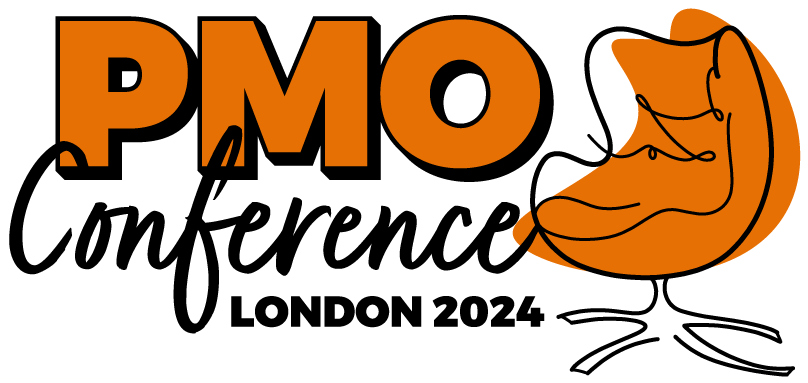You can find all our articles for Free Members
Types of PMOs – Governance Vs Organisation
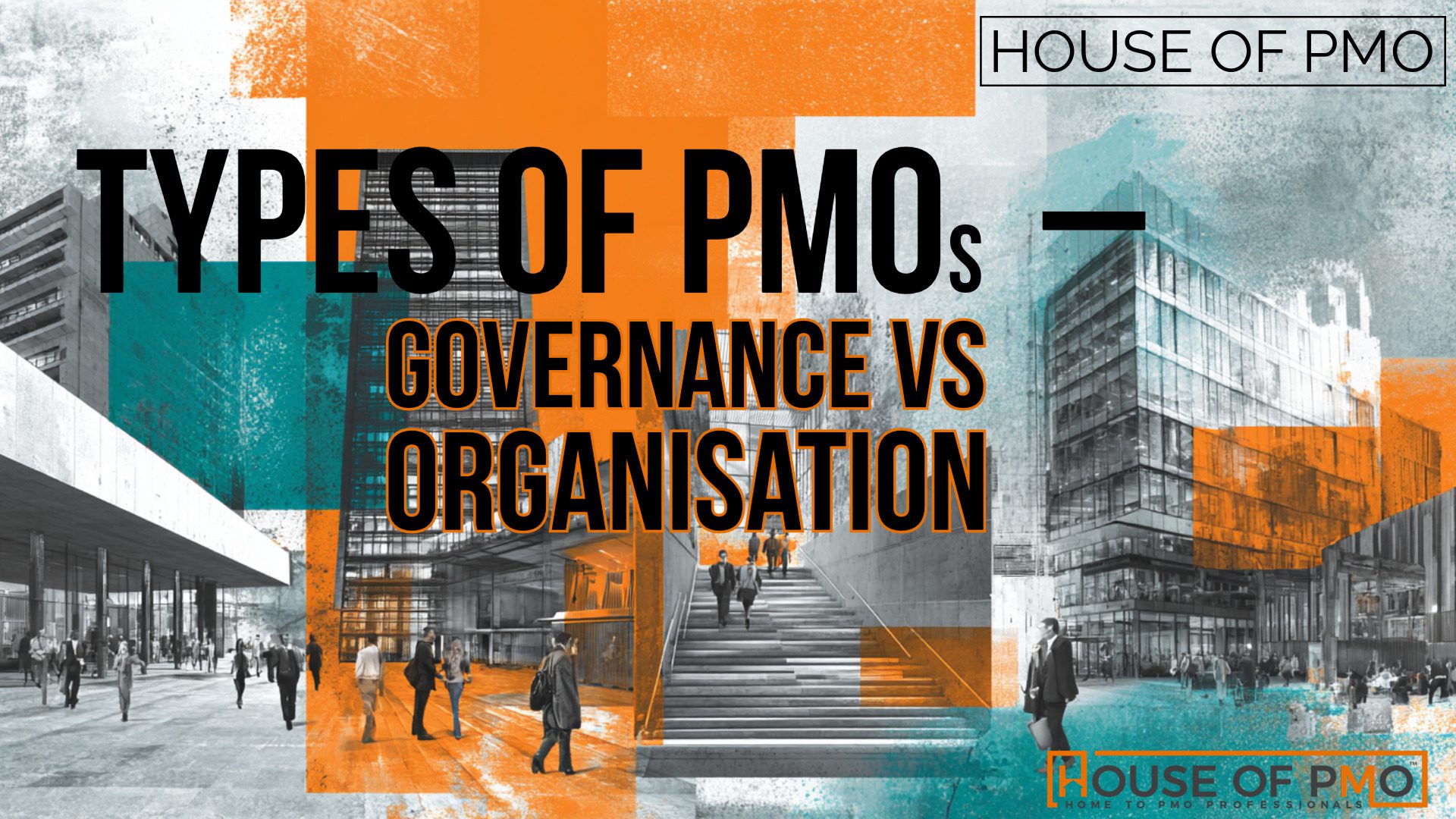

Understanding the Different Types of PMOs and Their Pros & Cons
In a recent PMO Flashmob, held at the University of Glasgow in Scotland, we heard a presentation from the PMO Manager where they spoke about their PMO journey over the last eight years.
We heard how their PMO initially took the form of a Supportive PMO, before evolving to a Controlling PMO before finally becoming a Challenging PMO today. They told a compelling story which will be heard at the PMO Conference in Edinburgh this coming November 2025.
In this article, we wanted to take the time to understand what these different types of PMOs are – and think about the different pros and cons of them. You might hear other PMO professionals talk about their PMOs as a Supportive PMO or just by the name, such as a Portfolio Office – so we want to unpick exactly what types of PMOs there are. Here’s what we’ll get into:
-
Governance style: how much control and influence the PMO exercises over delivery (Supportive → Controlling → Directive).
-
Organisational scope: where the PMO sits (Project, Programme, Portfolio/Enterprise, Departmental, Centre of Excellence, Transformation/Strategy Office).
PMO Governance Models: Supportive, Controlling, and Directive
One common way to classify PMOs is by the degree of control and influence the office has over projects. The Project Management Institute’s PMBOK Guide (5th Edition, 2013) outlined three basic PMO “modes of governance” based on their level of control: Supportive, Controlling, and Directive.
-
Supportive PMO – provides templates, best practices, training, lessons learned, and advisory information to project teams. It acts primarily as a repository and consultative body, with a low degree of control over projects. Project managers are largely autonomous, and the PMO’s role is to support rather than enforce.
-
Controlling PMO – provides support but also requires compliance with defined project management frameworks, standards, and tools. This type of PMO might enforce governance processes, conduct audits, and ensure project managers adhere to approved methodologies. It has a moderate degree of control, serving as a “PMO police” of sorts that balances guidance with enforcement.
-
Directive PMO – goes further by directly managing or owning projects. In a directive model, the PMO assigns project managers and takes charge of project execution and delivery, effectively exercising high control over projects. Project teams report into the PMO, which is responsible for outcomes. This model is typically used in organisations where a centralised approach is needed for critical projects or where project management maturity is lower and the PMO provides hands-on leadership.
These three governance models define how much authority the PMO wields. A supportive PMO is loose and advisory, a controlling PMO adds oversight and standards, and a directive PMO centrally runs projects. Below we examine each model in more detail, along with their advantages and disadvantages.
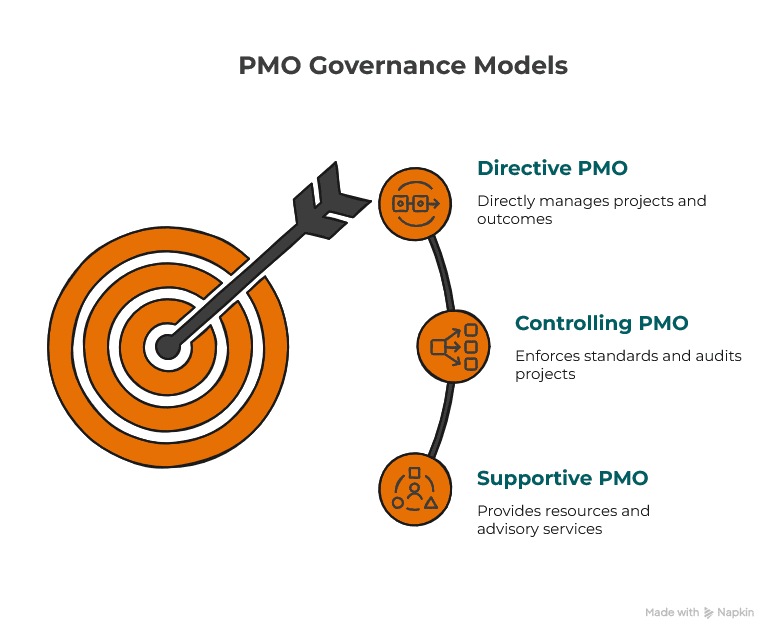
Supportive PMO
A Supportive PMO offers help and guidance to project teams but does not impose strict rules. It supplies things like project templates, best practice methodologies, training, and lessons learned from past projects. The supportive PMO is essentially a knowledge hub and coaching resource for project managers. Because it’s consultative rather than authoritative, project managers under a supportive PMO retain a high degree of independence in how they run their projects.
Advantages of a Supportive PMO:
-
Flexibility and Empowerment: Project managers can work with relative independence, which encourages autonomy and quicker decision-making without heavy bureaucracy. This flexibility can be ideal in creative or fast-paced environments where teams value freedom in managing their work.
-
Lower Overhead: The PMO’s light-touch involvement means it requires fewer resources and adds less administrative burden. This makes a supportive PMO cost-effective to operate. It serves as a central repository of knowledge and tools, but day-to-day project control remains with individual teams, avoiding extra layers of approval.
Disadvantages of a Supportive PMO:
-
Lack of Consistency: Without enforceable standards or oversight, each project may develop its own management approach. This can lead to inconsistency in execution and reporting across the organisation. Critical practices might be ignored if project managers choose not to utilise the PMO’s guidance.
-
Limited Control and Risk of Inefficiency: Because the PMO has little authority, it may not catch problems early. Projects in a complex or high-risk environment could go off track (e.g. miss deadlines or expand scope) since the PMO cannot intervene strongly. In organisations with low project management maturity, a purely supportive PMO might not provide enough oversight to ensure success.
- Administrative Support Only: Often the PMO is seen purely as secretariat support and little else which means the work is low level such as minute taking, updating logs and registers, booking meeting rooms and travel. PMO work at this level can lead to low motivation due to its repetitive nature which requires very little thought!
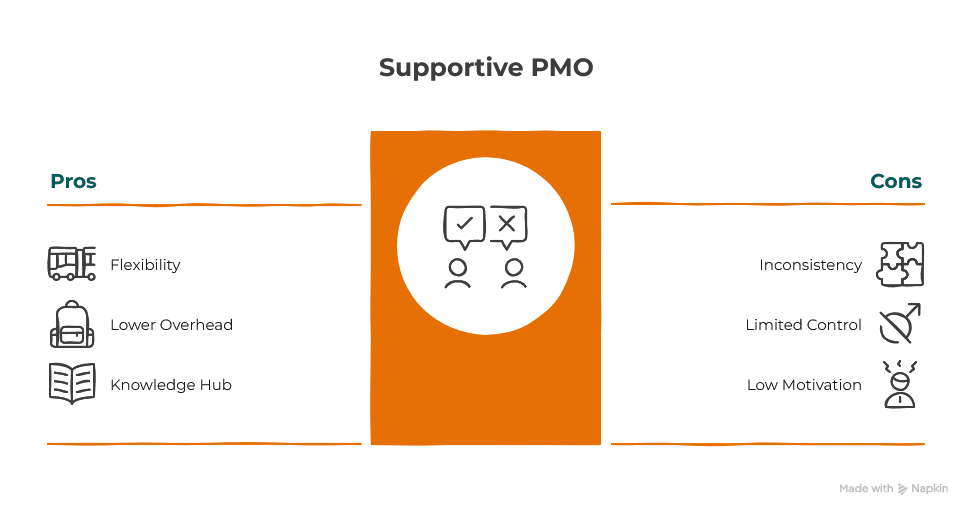
Controlling PMO
A Controlling PMO provides the same support as a supportive PMO plus an added layer of governance and standardisation. The controlling PMO establishes project management frameworks and requires teams to comply with defined processes, templates, and tools. It will regularly monitor projects for compliance – for example, performing audits or insisting on certain approvals and documentation. This model strikes a balance between support and control: project managers still run their projects, but within constraints and oversight set by the PMO.
Advantages of a Controlling PMO:
-
Standardisation and Consistency: By enforcing a common methodology and set of tools, a controlling PMO brings consistency to how projects are run. Standardised practices lead to more predictable project outcomes and make it easier to compare performance across projects. This consistency is valuable in organisations where multiple projects need to align to overall processes or regulatory requirements.
-
Better Risk Management and Quality Assurance: The added governance helps catch issues early and ensures key steps aren’t skipped. The PMO’s oversight can reduce the likelihood of project failures due to poor planning or non-compliance. In industries with heavy regulations (finance, healthcare, etc.), a controlling PMO helps fortify compliance and prevent costly mistakes.
-
Improved Project Efficiency: With clear guidelines, training, and templates from the PMO, project teams may work more efficiently, focusing on execution rather than reinventing processes. Projects are more likely to be completed on time and within budget when following well-defined procedures.
Disadvantages of a Controlling PMO:
-
Reduced Flexibility: The rigid processes and “PMO police” effect can stifle creativity or agility. Teams might feel constrained by formal procedures, which can be problematic for innovative or rapidly changing projects. In environments that require frequent pivots (e.g. tech startups or R&D projects), a controlling approach may be too inflexible.
-
Increased Overhead and Potential Bureaucracy: Enforcing compliance means more documentation, checkpoints, and administrative work. This added oversight can slow down decision-making and burden project managers with extra reporting. If not managed carefully, the PMO can become seen as bureaucratic red tape.
-
Possible Resentment or Resistance: Project managers and teams might resist the extra layer of control, especially if they were used to more autonomy. Without strong executive support, a controlling PMO may struggle if teams bypass it or if its value isn’t clearly demonstrated. It’s crucial that the PMO communicates the benefits of the controls and provides education, so it is viewed as a partner rather than an adversary. This was evident in the session from the University, with a controlling PMO leading to mistrust and increased stress, giving evidence that the approach was not suitable for their context and culture.

Directive PMO (and the “Challenging PMO”)
A Directive PMO takes the highest level of control by directly managing projects and providing project management staff to initiatives. In this model, the PMO is responsible for project execution – project managers often report into the PMO, which allocates resources and makes key decisions. This is common in organizations that want to centralise project management for consistency or in critical projects where senior oversight is needed. The PMO essentially becomes the delivery arm, ensuring all projects align with the business’s objectives and standards.
Advantages of a Directive PMO:
-
Unified Control and Alignment: Since the PMO itself runs the projects, it ensures every project is aligned with the organisation’s strategy and goals. There’s full accountability at the PMO level for project outcomes. This centralised control can be very effective for high-stakes projects where strict coordination is necessary (e.g. large infrastructure programmes or compliance-driven initiatives).
-
Accountability and Expertise: A directive PMO usually deploys its own experienced project managers and teams, which can raise the overall project management capability. It also means accountability is clear – the PMO cannot simply advise; it owns the results. With the PMO taking responsibility for success or failure, there is strong incentive to apply best practices and rigor.
-
Efficient Resource Management: The PMO can optimise resource allocation across projects since it has a bird’s-eye view of all projects in its portfolio. This enterprise-wide oversight helps avoid resource conflicts and can improve efficiency (e.g. pooling project support functions). The directive approach often works hand-in-hand with an Enterprise PMO structure (discussed below) to drive mission-critical programmes.
Disadvantages of a Directive PMO:
-
Reduced Project Manager Autonomy: Because the PMO takes charge, individual project managers and teams have less independence. Some may feel micro-managed or creatively constrained, which can affect morale and innovation. Talented project leads become disgruntled at not having full ownership of their projects.
-
High Resource Demand: Running projects directly requires a significant investment in PMO staff and infrastructure. A directive PMO effectively embeds itself in every project, so it must scale with the number and size of projects – which can be costly. Smaller organisations or those with limited budgets may find a fully directive PMO hard to justify unless the projects are critical.
-
Risk of Overcentralisation: With deep involvement in execution, a PMO can become a bottleneck if not structured well. Decision-making might slow if everything funnels through the PMO. There’s also the possibility of the PMO becoming too controlling (micromanagement), which could hinder project progress if every minor issue requires PMO approval.

These three definitions come directly from the PMI Body of Knowledge from 2013 – in practice these definitions can vary. For example, the Directive PMO in other parts of the world does not mean the Project Managers are part of the PMO. The term ‘directive’ can also be used to refer to a PMO which provides more of a critical friend role.
The PMO Manager’s story from Glasgow referred to their final stage as a “Challenging PMO, a mature directive PMO that actively challenges project teams and stakeholders to meet high standards and deliver strategic value.
In a challenging (directive) PMO, the office not only enforces process compliance, but also questions project assumptions, pushes for continuous improvement, and ensures each project’s justification and benefits are sound. This kind of PMO operates as a true partner to the business, albeit a tough one – it will hold projects accountable and even recommend cancelling or redirecting projects that don’t align with organisational objectives. The upside is a very high-impact PMO that can drive consistent success; the downside is that it requires strong executive backing and skilled staff to effectively challenge and lead across the organisation.
The Blending of PMO Governance Types
During the session, the attendees were given a typical scenario:
“The University has just discovered a major cost overrun in the ARC building project. The sponsor wants to push ahead regardless, but student representatives are furious about cuts elsewhere. The Vice-Chancellor is asking the PMO to recommend how to handle it.”
 We asked the attendees to get into groups, and to pick a PMO Governance model to think about their response. What would they do and why?
We asked the attendees to get into groups, and to pick a PMO Governance model to think about their response. What would they do and why?
What became clear is that there is a blending of the type of PMO – not every PMO falls neatly into only one of the above three categories – many PMOs blend characteristics to suit their environment, plus the people that work in the PMO also bring their own wealth of knowledge and experience which means different solutions and approaches are offered up.
A PMO might be largely supportive but enforce a few critical standards (mildly controlling), or it might directly manage only the most important projects while simply monitoring others. PMOs can also evolve over time – often beginning as supportive in a low maturity project culture, then adding controlling elements as governance needs grow, and perhaps taking on directive control for strategic programmes and projects – or when the level of project management maturity grows.
The attendees at the session offered up these suggestions for that scenario, could you categorise them into the correct type of PMO as defined by PMI?
-
Check the basics: Review the business case, agreed benefits, project status reports, and cashflow. Run a gate review if needed.
-
Independent input: Bring in an unbiased reviewer (like an external or another PM) to get a clear picture.
-
Corrective action plan: Work out how to fix issues, which could include value engineering, option analysis, or alternative proposals to keep costs and outcomes balanced.
-
Governance: If major changes are needed, take it through proper governance channels.
-
Communication: Be transparent, keep stakeholders informed, and manage expectations calmly – especially with students. Listen, gather their views, and make them feel heard.
-
Risk and solutions: Review risks, suggest different solutions (procurement, materials, fundraising, sponsors), and look at options A, B, C.
-
Stakeholder management: Focus on relationships, avoid panic, and facilitate constructive dialogue so the community stays engaged without fracturing.
PMO Types by Organisation Scope and Structure
Another way people describe “types of PMO” is by scope or level in the organisation. You might hear terms like Project Office, Programme Office, Portfolio Office, or Enterprise PMO. These refer to the breadth of the PMO’s influence – from a single-project support office up to a company-wide office. A widely used model is the P3O framework (Portfolio, Programme, and Project Offices), which recognises that an organisation may deploy multiple PMO structures simultaneously to address needs at different levels.
PMI’s Body of Knowledge, now in the 7th edition (2021), starts to acknowledge that PMOs can be structured in different ways to meet organisational needs, beyond the one-dimensional supportive/controlling/directive spectrum. These include:
-
Project PMO – Temporary, set up to support a single large project. Dissolves when the project closes.
-
Programme PMO – Oversees multiple related projects, managing interdependencies, risks, and benefits at the programme level.
-
Portfolio PMO / Enterprise PMO (EPMO) – Operates at the strategic level, aligning all projects and programmes with organisational goals, prioritising investments, and ensuring benefits realisation. It’s here that the Directive PMO finds a natural home.
-
Departmental/Divisional PMO – Embedded in a business unit (e.g. IT PMO), ensuring standards and coordination within that function.
-
Centre of Excellence (CoE) – Focuses on methodologies, standards, training, and capability-building rather than direct control of delivery.
-
Transformation / Strategy Delivery Offices – Emerging types set up to deliver enterprise-wide change or digital transformation programmes.
These scope-based types can overlap with governance models. For instance, a Programme PMO might be supportive (providing templates), controlling (enforcing standards), or directive (running projects directly).
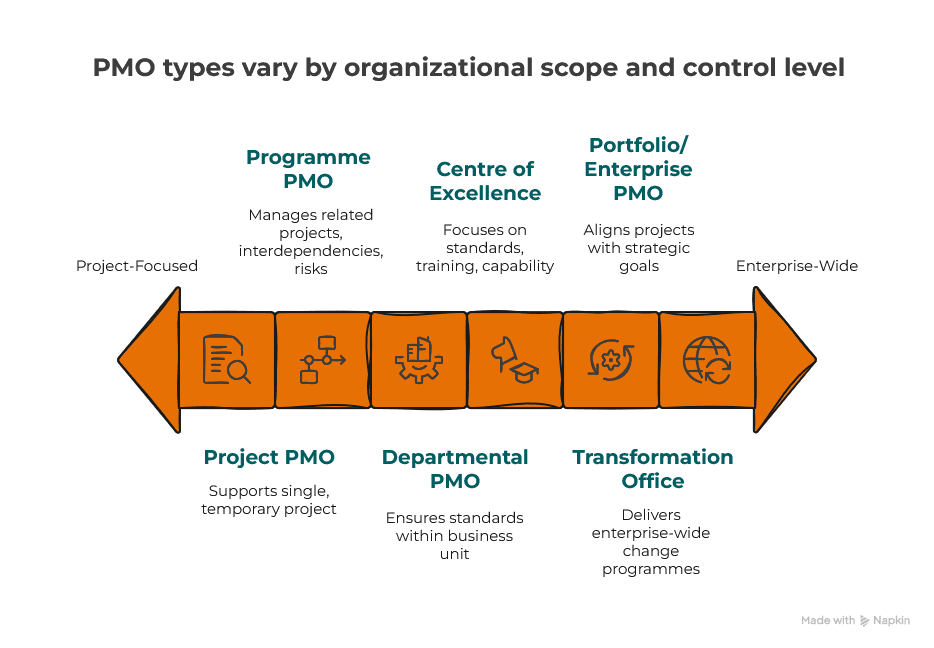
Governance, Organisation, Scope to Value Delivery
Bringing us up to the present day, PMI has also released numerous papers (see the resources below) which take the – what type of PMO – to another level.
The focus is no longer on whether a PMO is supportive or directive, but on whether it is helping the organisation achieve outcomes.
Concepts like xMOs – a catch-all for new-generation PMOs (Value Management Offices, Transformation Offices, Strategy Delivery Offices). These flexible, outcome-driven structures are less about enforcing process and more about ensuring the right work gets done and delivers value.
This represents a significant shift: the “type” of PMO is now less important than whether it enables strategy execution, agility, and benefits realisation.

The House of PMO View
From a PMO of One to enterprise-wide teams, PMOs come in all shapes and sizes. Whatever the setup, they’re here to help organisations deliver change more effectively.
At the House of PMO, we use the term PMO, not as an acronym, but as a collective noun to represent any individual, team, department or division that supports project, programme and portfolio management.
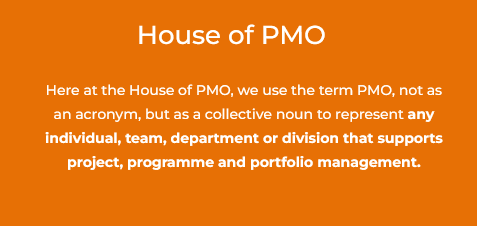
What Type of PMO Are You?
Most PMOs won’t fit neatly into a single category. They evolve, adapt, and blend characteristics as the organisation matures. The important question isn’t whether your PMO is supportive or directive, but whether it’s aligned with the needs of the organisation today.
For some, that may mean acting as a supportive knowledge hub. For others, it’s about tightening control and ensuring compliance. Increasingly, it’s about stepping up to be a strategic partner – a PMO that challenges, adapts, and delivers measurable value.
Resources
PMI: Which PMO is Right for Your Organization? (PMO types & structures) Project Management Institute
PMI/PwC report (PDF): The Evolution of PMOs: Delivering Value Through xMOs (value delivery focus) Project Management Institute
PMI Value Delivery hub: Maximising Return on Project Investments Project Management Institute
Portfolio standard (PMI): The Standard for Portfolio Management Project Management Institute
P3O overview (AXELOS): Portfolio, Programme and Project Offices (P3O) and UK training: PMO Learning: P3O® Axelos, PMO Learning
PMI recap of supportive/controlling/directive: PMO Evolution

